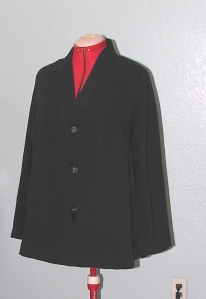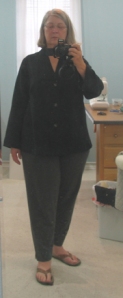The Tabula Rasa is from indie pattern company Fit For Art. As the name of the pattern indicates, the jacket is meant to be a blank slate for your piecing, color blocking, or embellishment. Likewise, the name of the company shows their concern about fit. Lots of art to wear jacket patterns are just big and boxy, I guess that you are supposed to ignore that and just look at the embellishments. This one, while still a relaxed fit, has eliminated much excess fabric and provided bust shaping. Details on that a little later.
We had a little cold snap here that made me realize I had a few tops that didn’t really work with my coats. A cardigan-like jacket with a warm lining would fill the bill. First I went to my Ottobre and Burda magazine binders, but didn’t find exactly what I was looking for. I’m glad I remembered this pattern that I’ve kind of had my eye on for a few years. It has a folkloric-type feel to the design that I like – a little bit like a kimono but with a skosh more fit.

The illustration on the pattern doesn’t do this design justice. That’s really too bad. The jacket is designed with no side seams. There is a side panel that, combined with the uniquely-shaped armscye, provides vertical princess-like lines front and back. A band finishes the center front and neckline, your choice whether to add a button or three or not.
On the topic of fit – you can tell that a nicely-fitted jacket is the designer’s goal here. There are two different front pieces included in the pattern – one for A/B busts, and one for C/D that has an extra set of bust darts rather than a single larger dart. There are also two different side panels – straight sides for narrow hips, and an angled side for full hips or if you want a swingier jacket. Horizontal balance lines are also included on the pattern. The intention is that you will first make an actual muslin muslin with the balance lines marked to aid in evaluating the fit and where adjustments are necessary. The very complete instructions (a 15-page booklet) advise making a real muslin with the balance lines, and then a wearable muslin in a fabric similar to the artsy fabric it assumes will be used for the final version. In addition to some fitting advice included in the booklet, there is an eleven-page document available on the website with instructions on how to address 16 common fit issues. Lining, interfacing, and seam finishes are all discussed in the instruction book.
Unlike other arty jackets, this one does not have extended shoulders. That’s one reason that the fit seems relatively trim. Also, a lot of fabric that is usually bunched up under the arm has been eliminated.
I skipped to the wearable muslin, but marked my balance lines in soap (washable jacket). I used one size up from the size recommended for my bust measurement, because I wanted a jacket that would fit over some other layers. I went ahead and made a forward shoulder adjustment before cutting out, and added an inch to the length. I had to cut an inch and a half off the sleeves. They were long!
The jacket went together very quickly. Took me about four hours to complete, and I am not Speedy McSeamstress by any means. It was fun to sew, too. The unique sleeve and lack of side seams mean that the construction is different, so I followed the steps in the booklet. They include lots of other specifics that are often left out, like which side to have on top when stitching and which way to press the seams. My only nit-picky point on the instructions is that there must be some tricks to making the finishing of the band a little easier. I’ll have to search through my Cutting Line patterns and see if there are some band finishing instructions that can be borrowed.

So…wearable muslin is done and I’m really pleased. Sorry the photos don’t tell much since it’s black. My only fit issue is that the upper back is a little wide, so I’ll consult the fitting document to see how they recommend adjusting that. I’ll also make the next one two and a half inches longer than designed. Some wool crepe is earmarked for the nice version, once I get some nice lining for it. I dabbled with embellishments for a little while and decided that they aren’t for me. I enjoy doing the work, but didn’t like wearing the garments. So plain wool crepe it is. Maybe with some topstitching to emphasize the seams.
You can probably tell that I like this jacket, since I wrote so darn much about it! It could be adapted to a nice tunic, too.

I made s denim muslin and have not had time to get back to the jacket. I can’t tell much from the black but I’m sure its great. I also ordered the T and the shirt changes to the jacket. I think the pattern is a sleeper.
Marciae from SG
Marcia, glad that you like the pattern,too. Yes, those black photos are awful! As soon as I get nice lining I will make it up in a lighter color wool crepe and make some more (better, I hope) photos.
Your recommendation is compelling, especially since a friend of mine has made a great vest with this pattern. So I’m off to buy it now! Thanks, Robyn.
Martha, I hope you like it as much as I do – but I think you are able to make absolutely anything work. 🙂
I think it is always interesting when the pattern makers throw something different at you. Nice jacket!
An interesting review. Thank you!
Great review, Robin! Those patterns have some serious endorsements. Claire Shaeffer is using the pants pattern for a pants fitting class.
The pants are really tempting, aren’t they? It really does mean something when Claire is using them to teach when she could use her own pants patterns.
Great shape of a jacket /shirt and one of my favourite silhouettes.Thanks for the hard work you’ve already done so we don’t have to.
This is a really good looking jacket. It appears to fit you well, and I like the shape of it on you. Glad you’re making it out of a fabric you love. Embellishment is certainly not for everyone, or every garment. I’m sure this is going to be a very wearable garment!
I took a two day class with Rae Cumbie, the designer of this jacket pattern. Day 1 was a trunk show, which was. wonderfully inspiring., Day 2 was a personal fitting of a muslin. This jacket looked wonderful on a wide variety of shapes and sizes. And it is easy to sew. It is also attractive when made of one fabric, for a more traditional look. I am looking forward to seeing your 2nd version.
Did you have any issues with deep diagonal folds on the sleeves? I’ve tried everything to get them out with no luck.